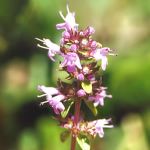| Common Name: |
American Pennyroyal |
| Other Names: |
Squaw mint |
| Botanical Name: |
Hedeoma pulegioides |
| Genus: |
Hedeoma |
| Family: |
Lamiaceae |
| Native Location: |
Eastern N America |
| Cultivation |
Rich, sandy soil in sun or partial shade. |
| Propagation |
By seed sown in autumn or spring. |
| Harvest |
Plants are cut wehn flowering and dried for use in infusions and liquid extracts, or distilled for oil. |
| Height: |
10-38cm (4-15in) |
| Width: |
7-24cm (3-10in) |
| Hardiness |
Hardy |
| Parts Used: |
Whole plant, oil. |
| Properties |
A pungently aromatic herb that stimulates the uterus, induces perspiration, improves digestion, and is expectorant. |
| Medicinal Uses: |
Internally for colds, whooping cough, indigestion, gas, nausea, painful menstruation, and childbirth (plant). Essential oil is extremely toxic and may cause death if taken internally. For use by qualified practitioners only. |
| Culinary Uses: |
Fresh or dried leaves can be used to make herb tea, or with discretion for flavoring. |
| Economic Uses: |
Oil is used in commercial food flavoring, insect repellents, and cleaning products. |
| Bibliography: |
Encyclopedia or Herbs ~ Deni Bown ~ copyright ©1995, 2001 Dorling Kindersley Limited. ~ pps 230-231.
|

